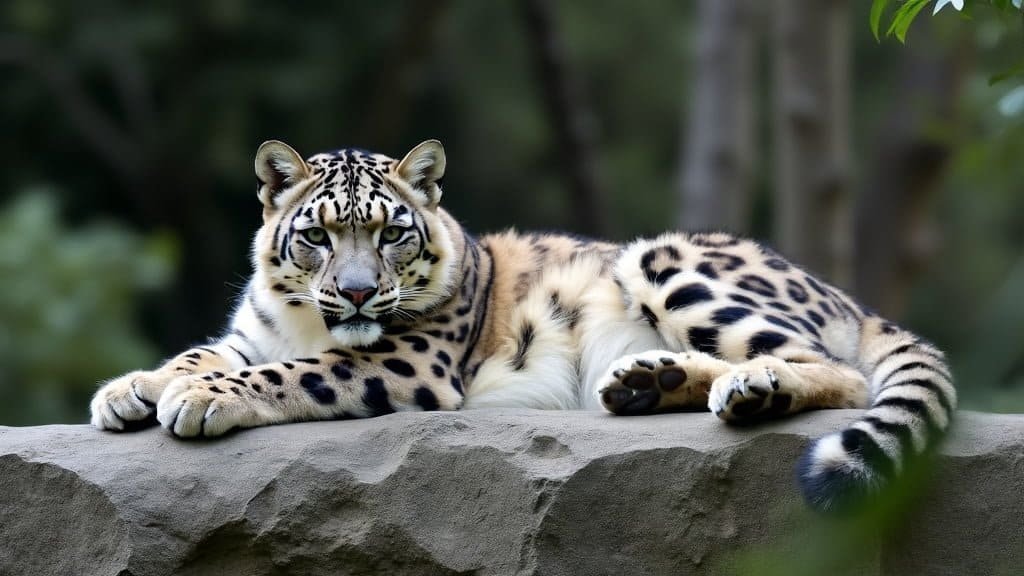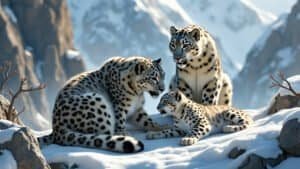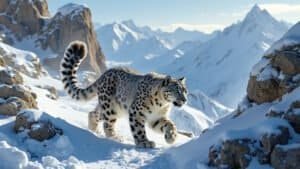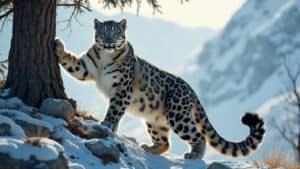Introduction
Snow leopards, the elusive big cats of the mountains, have fascinating daily activity patterns that vary throughout the day and across seasons. Understanding these patterns provides insight into their hunting habits, resting behaviors, and territorial dynamics
This article delves into the intricacies of their daily routines, examining how they hunt, rest, patrol their territories, and adapt to seasonal changes
We’ll also explore their movement patterns, care for young, and the unique factors that influence their behavior in the rugged and harsh environments they call home
Daily Hunting Habits
Snow leopards are solitary and elusive predators, primarily hunting in the early morning and late afternoon. Their hunting habits are adapted to their harsh mountainous environment, where they prey on various animals depending on the season and availability
Typical Hunting Times
Snow leopards are crepuscular hunters, meaning they are most active during dawn and dusk
These times provide optimal conditions for hunting as the low light offers camouflage, and many prey species are also active during these periods. This hunting schedule helps snow leopards conserve energy by avoiding the intense heat of midday and the coldest parts of the night
Primary Hunting Methods
Snow leopards are ambush predators. They rely on stealth and the element of surprise to catch their prey. Utilizing the rocky terrain to their advantage, they patiently stalk their target, often for several hours
Once close enough, they launch a sudden and powerful attack, aiming to deliver a fatal bite to the neck or throat of the prey. Their powerful hind legs allow them to leap great distances, sometimes up to 50 feet, to capture their target
The diet of snow leopards includes ibex, blue sheep, and other mountain ungulates. They also hunt smaller animals like marmots, hares, and birds when larger prey is scarce
The size and strength of their prey determine the frequency of their hunts; a successful kill of a large ungulate can sustain a snow leopard for up to two weeks
Seasonal Variations in Hunting
The hunting habits of snow leopards vary with the seasons. In winter, snow leopards move to lower altitudes following the migration of their prey, such as the blue sheep and ibex, which descend to avoid the deep snow
The snow leopard’s thick fur and large paws, which act like snowshoes, help them navigate the snowy terrain effectively
In summer, they ascend to higher altitudes where prey animals move to graze. The lack of foliage in the higher altitudes means snow leopards rely even more on their stealth and rocky cover for successful hunts. Additionally, summer brings an increase in smaller prey availability, such as marmots, which are more active during the warmer months
Snow leopards are opportunistic hunters and will take advantage of any hunting opportunities that arise, including scavenging on carrion if available. This adaptability is crucial for their survival in the extreme and variable conditions of their habitat
Environmental Factors Influencing Hunting
Several environmental factors influence the hunting patterns of snow leopards. The rugged and often harsh terrain of their mountainous habitat provides both challenges and advantages for hunting
The steep slopes and rocky outcrops offer excellent vantage points for spotting prey and launching ambushes, but they also require significant energy expenditure to navigate
Weather conditions play a significant role as well. Heavy snowfall can impede movement and visibility, making hunting more challenging. However, snow leopards are well adapted to snowy conditions, and their thick fur provides insulation against the cold, while their wide paws distribute their weight evenly to prevent sinking into the snow
Human activities also impact snow leopard hunting habits. In regions where livestock grazing encroaches on their natural habitat, snow leopards may prey on domestic animals, leading to conflicts with herders
Conservation efforts are focused on mitigating these conflicts through community-based programs that promote coexistence and protect both snow leopards and livestock
Rest and Recuperation
Snow leopards, like other big cats, require significant periods of rest and recuperation to maintain their energy levels for hunting and territorial activities. Their resting habits are shaped by their environment and biological needs, ensuring they stay healthy and effective predators
Daytime Resting Spots
Snow leopards typically choose secluded and elevated spots for daytime rest. These locations offer safety from potential threats and a good vantage point to observe their surroundings
Common resting places include rocky outcrops, caves, and ledges that provide shelter from the elements and a strategic view of their territory
These big cats are often found lying on sunlit rocks during the day, especially in colder months, to absorb warmth. In warmer seasons, they seek shaded areas to avoid the heat. The selection of resting spots is crucial for conserving energy, as the rugged terrain of their habitat requires significant effort to navigate
Nighttime Resting Habits
At night, snow leopards tend to be less active, using the darkness to rest and recuperate
They find sheltered spots that offer protection from nocturnal predators and harsh weather conditions. These nighttime resting places are often the same as their daytime spots, providing consistency and familiarity in their routine
Snow leopards may also take short naps throughout the day and night, allowing them to remain alert and responsive to any changes in their environment. This intermittent resting pattern helps them conserve energy while staying prepared for hunting opportunities or potential threats
Environmental Factors Influencing Rest
The environment plays a significant role in the resting habits of snow leopards. The harsh and variable weather conditions of their mountainous habitat require them to find spots that offer protection from wind, snow, and rain
Their thick fur provides insulation, but finding a sheltered location is crucial for maintaining body heat and staying dry
Seasonal changes also impact their resting behavior. In winter, snow leopards may rest more frequently to conserve energy in the cold and snowy conditions. In contrast, during the warmer months, they may rest in shaded areas to avoid overheating
The availability of prey also influences their rest patterns; after a successful hunt, they can afford longer rest periods
Human activities and habitat encroachment can disrupt their natural resting habits. Increased human presence and livestock grazing in their habitat can force snow leopards to change their resting spots, potentially exposing them to greater risks. Conservation efforts aim to minimize these disturbances by promoting coexistence and protecting critical habitats
Territorial Behaviors
Snow leopards are solitary and territorial animals, with each individual maintaining a large home range. Their territorial behaviors are essential for securing resources, finding mates, and ensuring survival in their harsh mountainous environments
Territory Patrol Patterns
Snow leopards regularly patrol their territories to mark boundaries and check for intruders. This patrolling is typically done at dawn and dusk, aligning with their crepuscular activity patterns
The size of a snow leopard’s territory can vary significantly based on the availability of prey, ranging from 20 to 200 square miles
During patrols, snow leopards use specific routes that maximize their ability to detect signs of other leopards. They often follow ridgelines, valleys, and trails, which provide good visibility and strategic points for marking territory
Patrolling is energy-intensive, but it is crucial for maintaining control over their range and ensuring access to food resources
Marking and Defending Territory
Snow leopards use various methods to mark their territory, including scent marking, scrapes, and vocalizations. Scent marking involves spraying urine or rubbing their cheeks on rocks and trees, leaving chemical signals that other leopards can detect
Scrapes are created by raking their hind paws on the ground, often accompanied by urine marking, to leave a visual and olfactory sign of their presence
Defending their territory is vital, especially for males, as it ensures access to females for mating. Territorial disputes can lead to aggressive encounters, though physical fights are relatively rare. Snow leopards prefer to use visual and vocal signals to deter intruders and avoid direct confrontation
Interaction with Other Snow Leopards
While snow leopards are generally solitary, they do interact with other leopards, particularly during the mating season
Males and females come together for breeding, with the male typically leaving the female’s territory after mating. Mothers also interact closely with their cubs, providing care and teaching essential survival skills until they are old enough to be independent
Occasionally, overlapping territories can lead to encounters between neighboring snow leopards. These interactions are usually brief and involve mutual assessment through scent and visual cues. Understanding these interactions is crucial for conservation efforts, as it helps in managing habitats to reduce conflicts and support population stability
Human activities can impact the territorial behaviors of snow leopards. Habitat fragmentation, increased human presence, and livestock grazing can force snow leopards to alter their territories and patrol patterns, potentially leading to increased conflicts and stress
Conservation strategies focus on preserving large contiguous habitats and minimizing human-wildlife conflicts to support the natural territorial behaviors of snow leopards
Adaptation to Seasons
Snow leopards are highly adapted to the extreme seasonal variations in their mountainous habitats. Their behavior, hunting strategies, and territorial patterns change significantly with the seasons to ensure their survival in both the harsh winters and the relatively milder summers
Activity Changes in Winter
During winter, snow leopards descend to lower altitudes following the migration of their prey, such as blue sheep and ibex
These animals move to lower elevations to avoid deep snow and find more accessible forage. Snow leopards take advantage of these movements, adjusting their territory and hunting grounds accordingly
The thick fur of snow leopards provides excellent insulation against the cold, while their wide paws help them move efficiently through deep snow. Winter conditions require snow leopards to conserve energy, so they may rest more frequently and hunt less often
However, when they do hunt, they capitalize on the prey’s restricted movements due to the snow, increasing their chances of a successful kill
Activity Changes in Summer
In the summer, snow leopards move to higher altitudes where temperatures are cooler, and prey animals migrate to graze on alpine meadows. The lack of snow allows for greater mobility, enabling snow leopards to patrol larger areas and expand their hunting grounds
During this period, their diet becomes more varied as they hunt smaller prey like marmots, which are more active in the warmer months. Snow leopards also take advantage of the increased availability of water sources, which are more plentiful in the summer due to melting snow
Impact of Prey Availability
Prey availability is a critical factor influencing snow leopards’ seasonal adaptations. The migratory patterns of prey species like blue sheep and ibex dictate the movements and hunting strategies of snow leopards
During times of scarce prey, snow leopards may expand their territories and travel greater distances to find food
In winter, when large prey is harder to find, snow leopards may resort to hunting smaller animals or scavenging carrion. They have also been known to hunt livestock in areas where their natural prey is depleted, leading to potential conflicts with humans
Behavioral and Physical Adaptations
Snow leopards possess several behavioral and physical adaptations that aid their survival through seasonal changes. Their large nasal cavities warm the cold air before it reaches their lungs, and their long, thick tails provide balance and warmth when wrapped around their bodies during rest
Seasonal changes also affect their reproductive behaviors
Mating typically occurs in late winter, and cubs are born in the spring or early summer when conditions are more favorable for rearing young. This timing ensures that the cubs have the best chance of survival, with abundant prey and milder weather during their early months
Human Impact on Seasonal Adaptations
Human activities can disrupt the seasonal adaptations of snow leopards. Climate change, habitat fragmentation, and increased human presence can alter the availability and distribution of prey, forcing snow leopards to adapt their behavior in ways that may be detrimental to their survival
Conservation efforts aim to mitigate these impacts by preserving critical habitats, promoting coexistence between humans and snow leopards, and ensuring that prey populations remain stable. By understanding how snow leopards adapt to seasonal changes, conservationists can develop strategies to support these adaptations and enhance the resilience of snow leopard populations
Movement and Travel
Snow leopards are known for their impressive mobility across some of the most challenging terrains in the world. Their movement and travel patterns are dictated by the need to patrol their territory, find prey, and avoid threats
Understanding these patterns is essential for conservation efforts aimed at protecting their natural habitats and ensuring their survival
Daily Travel Distances
Snow leopards cover significant distances in their daily movements
On average, a snow leopard may travel up to 10 miles in a single day while patrolling its territory and searching for prey. These daily travels are crucial for maintaining their territory and ensuring access to sufficient food resources
The actual distance traveled can vary based on several factors, including the availability of prey, the size of the territory, and environmental conditions
In regions with abundant prey, snow leopards might travel shorter distances, while in areas where prey is scarce, they may need to cover more ground
Factors Affecting Movement
Several factors influence the movement patterns of snow leopards. The rugged terrain of their mountainous habitat requires significant physical effort to navigate, and snow leopards are well adapted for this with their powerful limbs and flexible bodies
Their large paws act like snowshoes, distributing their weight and allowing them to move efficiently through deep snow
Seasonal changes also play a significant role in their movement. In winter, snow leopards tend to move to lower altitudes where prey is more accessible, while in summer, they move to higher altitudes following the migratory patterns of their prey. These seasonal movements help ensure a steady supply of food throughout the year
Human activities, such as livestock grazing and infrastructure development, can disrupt the natural movement patterns of snow leopards
Habitat fragmentation caused by roads, settlements, and other human activities can force snow leopards to travel longer distances to find prey and suitable resting spots, increasing the risk of human-wildlife conflicts
Role of Terrain in Movement
The mountainous terrain of snow leopard habitats is characterized by steep slopes, rocky outcrops, and deep valleys
This rugged landscape provides both challenges and advantages for their movement. Steep slopes and cliffs offer vantage points for spotting prey and ambush sites, while rocky outcrops provide cover for stalking and resting
Snow leopards are incredibly agile and capable of making large leaps, often covering distances of up to 50 feet in a single bound. This agility allows them to traverse difficult terrain with ease and is crucial for both hunting and evading potential threats
The terrain also dictates the paths snow leopards take during their patrols. They often follow ridgelines and valleys, which offer easier travel routes and better visibility for detecting prey and intruders. These natural pathways are integral to their daily and seasonal movements
Impact of Prey Availability on Movement
Prey availability is a critical factor influencing the movement and travel patterns of snow leopards
In areas with high prey density, snow leopards can maintain smaller territories and travel shorter distances to find food. Conversely, in regions where prey is sparse, they need to cover larger areas to meet their nutritional needs
Seasonal migrations of prey species like blue sheep and ibex directly impact snow leopards’ movements. Snow leopards follow these migrations, adjusting their territories and travel routes accordingly
This dynamic relationship between predator and prey is essential for the survival of snow leopards in their harsh environments
Conservation Implications
Understanding the movement and travel patterns of snow leopards is crucial for effective conservation planning. Protecting large, contiguous habitats that accommodate their wide-ranging movements is essential for their survival
Conservation efforts also focus on creating wildlife corridors that allow safe passage between fragmented habitats, reducing the risk of human-wildlife conflicts and ensuring genetic diversity
Community-based conservation programs that promote coexistence between humans and snow leopards are also vital. These programs help mitigate the impacts of human activities on snow leopard movements and promote sustainable practices that benefit both wildlife and local communities
Care for Young
The care and nurturing of cubs are critical aspects of snow leopards’ lives, ensuring the survival of the next generation. Female snow leopards exhibit dedicated maternal behaviors to raise their young in the challenging environments of their mountainous habitats
Maternal Behaviors
Snow leopard mothers are solely responsible for the care of their cubs. After a gestation period of about 93 to 110 days, females give birth to litters typically consisting of one to three cubs, though up to five cubs have been recorded
Births usually occur in well-hidden dens, often located in rocky crevices or caves, which provide protection from the elements and predators
For the first few weeks, the mother stays close to the den, leaving only briefly to hunt. She ensures the cubs are kept warm and well-fed, relying on her reserves and the food she brings back. Cubs are born blind and helpless, opening their eyes at around seven days old
The mother’s constant presence and care are crucial during this vulnerable period
Teaching Hunting Skills
As the cubs grow older, usually around two to three months, the mother begins to take them out of the den to explore their surroundings
This period is essential for teaching the cubs crucial survival skills. The mother demonstrates hunting techniques, such as stalking and ambushing prey, which the cubs practice through play
By around six months of age, the cubs start participating in hunts. The mother continues to provide guidance and support, ensuring the cubs learn the necessary skills to hunt independently. These lessons are vital for their survival once they leave their mother’s care
Protection from Predators
Snow leopard mothers are highly protective of their cubs. The choice of den location is strategic, minimizing the risk of predation from other large carnivores, such as wolves and eagles. The rocky and inaccessible nature of the den sites provides additional security
During their early months, cubs are vulnerable to predation, and the mother’s vigilance is paramount. She keeps her cubs hidden and minimizes their exposure to potential threats. Even as the cubs grow and become more mobile, the mother remains alert, ready to defend them if necessary
Cubs’ Development and Independence
Cubs develop rapidly, gaining strength and agility as they grow. By the time they are around 18 to 24 months old, they are nearly full-grown and capable of surviving on their own. The mother gradually reduces her care as the cubs become more self-sufficient, encouraging them to explore and establish their own territories
Once the cubs reach independence, they typically disperse to find their own home ranges
This dispersal helps prevent inbreeding and ensures genetic diversity within the population. The transition to independence is a critical period, as young snow leopards must apply the skills they have learned to secure their own food and avoid dangers
Conservation Implications
Understanding the care and nurturing of snow leopard cubs is essential for conservation efforts
Protecting denning sites and ensuring safe habitats for raising young are crucial components of snow leopard conservation. Efforts to reduce human disturbance and mitigate threats from poaching and habitat loss directly benefit the survival rates of cubs
Conservation programs that engage local communities in protecting snow leopard habitats help ensure that critical denning areas remain undisturbed. Education and awareness initiatives highlight the importance of preserving these environments for the continued survival of snow leopards and their young
By focusing on the care and nurturing behaviors of snow leopards, conservationists can develop strategies that support the successful rearing of cubs, ensuring the long-term viability of snow leopard populations
Conclusion
Understanding the daily activity patterns of snow leopards is essential for their conservation and protection. These elusive big cats have adapted remarkable behaviors to thrive in some of the harshest environments on Earth
From their crepuscular hunting habits and strategic resting spots to their extensive territorial patrols and seasonal migrations, snow leopards exhibit a range of behaviors that ensure their survival
Their movement and travel patterns, influenced by prey availability and terrain, highlight the importance of preserving large, contiguous habitats. The dedicated care they provide to their young underscores the need for safe and undisturbed environments for raising the next generation. Human activities, climate change, and habitat fragmentation pose significant threats to these behaviors, making conservation efforts vital
By studying and protecting the daily activities and habitats of snow leopards, we can develop effective strategies to support their natural behaviors, promote coexistence with local communities, and ensure their continued survival in the wild













